Welcome to one of the most active flamenco sites on the Internet. Guests can read most posts but if you want to participate click here to register.
This site is dedicated to the memory of Paco de Lucía, Ron Mitchell, Guy Williams, Linda Elvira, Philip John Lee, Craig Eros, Ben Woods, David Serva and Tom Blackshear who went ahead of us.
We receive 12,200 visitors a month from 200 countries and 1.7 million page impressions a year. To advertise on this site please contact us.
|

|
|
Bad notes in classical guitars
|
You are logged in as Guest
|
|
Users viewing this topic: none
|
|
Login  | |
|

   
Ricardo
Posts: 14819
Joined: Dec. 14 2004
From: Washington DC

|
 RE: Bad notes in classical guitars (in reply to NorCalluthier) RE: Bad notes in classical guitars (in reply to NorCalluthier)
|
|
|
quote:
ORIGINAL: NorCalluthier
Hello All,
It would be nice to be able to make just flamenco guitars as I play flamenco, and can judge their quality from a player's perspective. Though I listen to classical guitar all the time---flamenco is too distracting in the shop---I don't play any.
Classical guitarists are, shall we say, particular? They want even response up in the high treble region where I hardly ever venture---I only get to the 10th fret in one falsetta in Granadinas.
So, presuming that you flamenco builders build classicals as well, what do you do to avoid bad notes up in the treble, or to fix them when they do occur?
My bracing pattern is a variation on the Romanillos//Elliott open cross bar design.
Cheers,
Brian
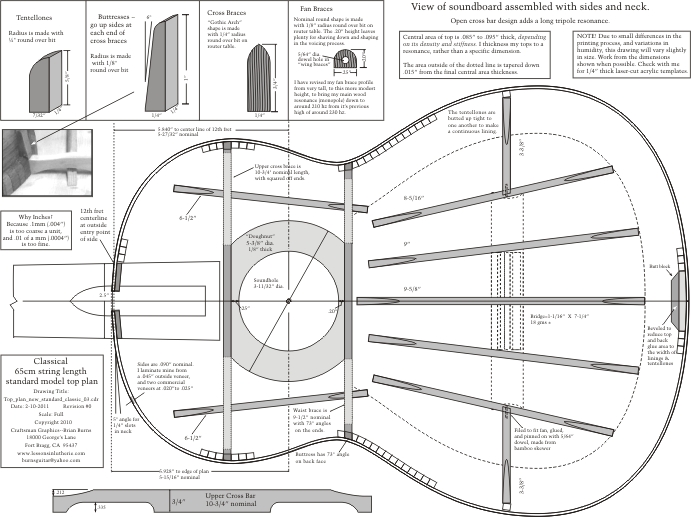
As a player, I have to question this "bad note" phenomenon that only classical guitarists seem to have. "Wolf note" etc, I think players suddenly notice that their guitar soundboard has been "tuned" and it bothers them. Flamenco players tend to be more aware of this probably because we use amplification so often where certain frequencies might become problematic.
Images are resized automatically to a maximum width of 800px
_____________________________
CD's and transcriptions available here:
www.ricardomarlow.com
|
|
|
|
REPORT THIS POST AS INAPPROPRIATE |
Date Jul. 10 2017 22:46:02
 |
|

   
estebanana
Posts: 9352
Joined: Oct. 16 2009

|
 RE: Bad notes in classical guitars (in reply to NorCalluthier) RE: Bad notes in classical guitars (in reply to NorCalluthier)
|
|
|
I agree with Ricardo. Most of the problems classical players find with guitars are because they are weak at tone production. Most classical players are weak at bringing out all the potential of a guitar because they are not robust players at drawing out projection. They tend to blame the guitar if they can't master every area on the fingerboard map.
Guitars are always based on a series of trade off qualities and many guitar players don't understand their own sound enough to work with all guitars. They expect the guitar will perform for them without putting in the work to learn how that particular guitar needs to be worked.
Advanced classical players get this stuff, but in general I think Flamenco players learn better tone production faster than classical players. I pretty much don't listen to classical players any longer unless they are highly accomplished players, or unless the have figured out technique to achieve really big beautiful tone. Until they attain that level most of things they say critically about guitars are not worth much to a builder. They just don't have the technique to really pull the sound out of a guitar and they are not a good judge of the way the guitar works. Flamenco students attain a deeper understanding of tone production and projection sooner, they have more reasonable things to say about tension and playability.
I've had so many bad experiences with classical players with various guitars I've made, and them blaming the guitar for having 'wolf tones' or bad notes, only to find out it's a minor set up issue or a non existent problem. Or simply that the player is poor at tone production, clawing at the strings for example. Or just plain prejudiced against those to mainly build flamenco guitars. One particular guitar I took to a dealer who soundly pooped on it, but he could not play very well. Later a professional player borrowed it to make a recording. Many years ago I showed a guitar to a hot shot child player who was about ten years old. The child whined and dissed the guitar, said is was bad. The parents were supportive of the child and said if he says it's bad, it's bad. About a week later a gigging adult professional player bought the guitar. He thought it was very nice.
The moral of the story is: Spank a child, starve a therapist.
And bear in mind that classical guitarists may suffer from 'Princess and the Pea' syndrome and feel lumps where there are no lumps. If you show your work to "Classical" players with a capital 'C', be prepared for a litany of neurotic judgments from about one third of them.
From classical players, only take heart in a critique given by a top level player. " I know what I like." from a player usually translates as "I like what I know."
_____________________________
https://www.stephenfaulkguitars.com
|
|
|
|
REPORT THIS POST AS INAPPROPRIATE |
Date Jul. 12 2017 2:25:37
 |
|

   
NorCalluthier
Posts: 136
Joined: Apr. 16 2016

|
 RE: Bad notes in classical guitars (in reply to NorCalluthier) RE: Bad notes in classical guitars (in reply to NorCalluthier)
|
|
|
Hello All,
Thanks very much for all the replies!
To answer your question Ricardo, I didn't try different strings on that ultra-light that had the extra loud notes. Since it has a Euro-spruce top, I figured that its response was going to change a lot in a few months, and that I would re-visit it then. That guitar was bought by an exclusively classical player who doesn't play flamenco at all! Go figure (;->)...
Classical players are notoriously fussy, but I certainly can hear what they are hearing when a treble note has little sustain. Jeff Elliott says that a bad note will often "play out" over time, but an advanced classical player that I spoke with had a Ramirez that he loved and played for years. It had a bad C#---9th fret of the 1st string---that stayed dead.
I've made a cedar topped classical that has delighted a number of good players, except for the D#---11th fret of the 1st string---which has little sustain. Whether I play that note picado or pulgar, really punch it or play it softly, it's quite obviously weaker than the surrounding notes. I've tried "mass loading" the top in various places with Poster Tac, but with little effect.
Hello Stephen, I think that adding cross grain stiffness to the top as a means of controlling wolf notes and "bad notes" is a good idea. My bracing pattern produces a killer "cross tripole" resonance up in the high treble region. In final voicing I try to get that resonance to move to exactly halfway between two scale tones, but it seems to affect notes anyway.
Cheers,
Brian
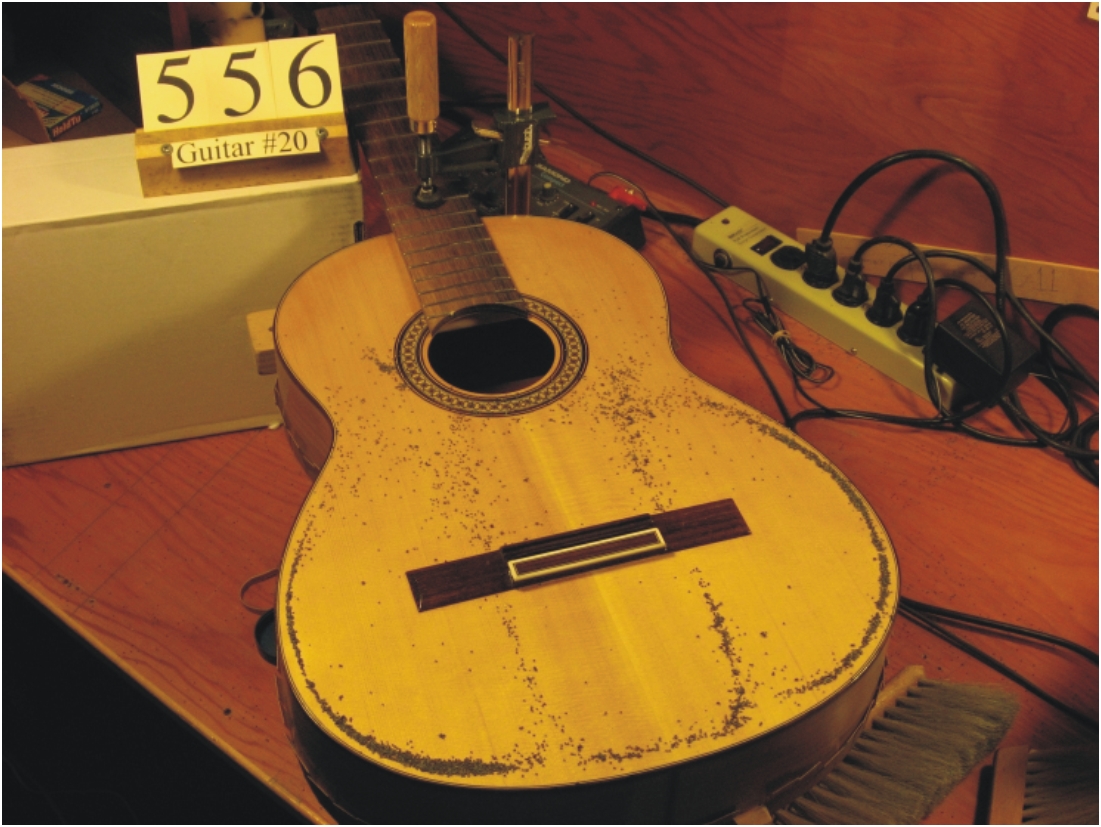
Images are resized automatically to a maximum width of 800px
 Attachment (1) Attachment (1)
|
|
|
|
REPORT THIS POST AS INAPPROPRIATE |
Date Jul. 13 2017 15:50:04
 |
|

   
Ricardo
Posts: 14819
Joined: Dec. 14 2004
From: Washington DC

|
 RE: Bad notes in classical guitars (in reply to NorCalluthier) RE: Bad notes in classical guitars (in reply to NorCalluthier)
|
|
|
quote:
To answer your question Ricardo, I didn't try different strings
Well, in all cases, please try it. You might be surprised. I find strings to be the number one culprit as far as guitar "faults" are concerned. Fingers, number 2. Humidity number 3.
I have "fixed" various guitars' actions, intonation, brightness, warmness, sustain, percussiveness, volume,"pulsation", responsiveness, "flamenconess", etc, whatever adjectives, simply by experimenting with different string brands and tensions.
Ricardo
_____________________________
CD's and transcriptions available here:
www.ricardomarlow.com
|
|
|
|
REPORT THIS POST AS INAPPROPRIATE |
Date Jul. 14 2017 14:15:15
 |
|

   
NorCalluthier
Posts: 136
Joined: Apr. 16 2016

|
 RE: Bad notes in classical guitars (in reply to NorCalluthier) RE: Bad notes in classical guitars (in reply to NorCalluthier)
|
|
|
Hello Ricardo,
I will take your advice.
I recently "fixed" the first classical I've made to a "larger" plantilla by switching strings. My standard brand and tension is good old normal tension D'Addario J45's, with a Savarez Alliance third string. With those on the "larger" model guitar, the treble just couldn't keep up with the big bass.
My "larger model" is not only about 2% larger in every dimension than my "standard" model, it is voiced a half step lower. I was trying to see if I could make a more modern style instrument that would compare favorably with the larger classicals.
I get strings from Strings by Mail, and they were praising Dogal's new "Mastrales", so I swapped in a set of those---in spite of their hefty price. That did the trick, and the treble came up to match the bass in volume---with one caveat:
Dogal supplies one of their regular nylon first strings for replacing the Mastrale first string, and a good classical player, who played the guitar for a time, preferred the standard nylon first string. Though I don't play classical, I'm inclined to agree with him that the Mastrale first string sounded a bit "tinny". The Mastrale trebles are opaque blue in color, which is a bit disconcerting visually.
By the way, I didn't notice any difference between the D'Addario basses and the Mastrale basses. I should try just using the Mastrale trebles with the D'Addario basses.
I have to guard against getting involved in yet another research project, so trying out different strings has not gotten much attention---the "boy scientist" in me is readily seduced, while the bills are crying out to be paid (;->)...
So what advice would you give for brands and tensions to try, and for what problems?
Many thanks for taking the time and trouble to post answers to my question.
Cheers,
Brian
|
|
|
|
REPORT THIS POST AS INAPPROPRIATE |
Date Jul. 14 2017 15:50:22
 |
|

   
NorCalluthier
Posts: 136
Joined: Apr. 16 2016

|
 RE: Bad notes in classical guitars (in reply to NorCalluthier) RE: Bad notes in classical guitars (in reply to NorCalluthier)
|
|
|
Hello again Stephen,
After sleeping on your advice to try changing the cross grain stiffness of the top, I think I will try making a copy of Jeff Elliott's bracing pattern which uses seven fans instead of my five. His design is covered in an article in the Fall 2016 American Lutherie, and the Guild sells full size drawings.
I took a class from Jeff and Cyndy perhaps twenty years ago, and Jeff said that he liked the open crossbar design, but that it was "more difficult to control". He advised that we stick with the 1942 Hauser pattern.
I didn't see a reason to change to the open cross bar design until I ran across a page of holograms in "Engineering the Guitar" by French. It showed a resonance that I hadn't seen in my guitars, and it was right up in the high treble region where Jeff's guitars really shine. Trevor Gore's words of wisdom are that the more resonances, the richer the tone, provided that you can keep them off of a scale tone.
I checked with the author of the book, and the guy that took the holograms, and neither of them knew anything at all about the guitar. I surmised that to get that much activity in the upper bout---it seems the strongest---the guitar must be using the open cross bar bracing of Romanillos//Elliott---a guess, I know.
So I came up with the design in the drawing that you see earlier in this thread. It has been working very well for me on my flamencos, and except for the occasional bad note well up the first string, on my classicals as well.
Cheers,
Brian
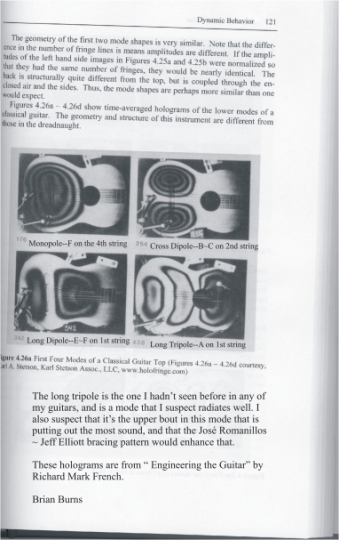
Images are resized automatically to a maximum width of 800px
 Attachment (1) Attachment (1)
|
|
|
|
REPORT THIS POST AS INAPPROPRIATE |
Date Jul. 14 2017 16:31:10
 |
|

   
NorCalluthier
Posts: 136
Joined: Apr. 16 2016

|
 RE: Bad notes in classical guitars (in reply to NorCalluthier) RE: Bad notes in classical guitars (in reply to NorCalluthier)
|
|
|
Hello Stephen,
I think the open cross bar design has little to do with cross grain stiffness. My version of it deviates from Jeff's in that I get cross grain stiffness with the two little "wing braces", and I'm thinking that doesn't make up for eliminating the traditional bridge patch. In Jeff's latest version of his bracing pattern he has widened his bridge patch somewhat. Also I'm using five fans instead of his seven.
The best treble that I ever heard in a classical was at a GAL convention, in 1995 or 1997. There were 33 guitars played in a classical guitar listening session with about a hundred in the audience. Jeff's guitar was the only one applauded. It had that clear bell like treble that I only dream about producing. Everybody could hear it!
That guitar used Jeff's version of Romanillo's open crossbar design. The question is whether that great treble was because of, in spite of, or was not affected by his bracing plan. I don't pretend to know.
By the way, when I worked for Gene Clark in 1963, he was trying to get activity into the upper bout. On Freddy Mejia's all spruce flamenco he ran the four fans from under the bridge, through the two cross bars, and into the upper bout. He showed me on that guitar how salt would bounce up and down in the upper bout when he plucked a string.
On a maple flamenco that he built for Dave Borson in 1964 he left off the upper cross bar altogether. At that time he "wasn't ready" to open up the cross bars, and I don't know if he ever did try opening them up.
With the bracing plan that I'm using I'm getting good treble, with the exception of one or two weak notes---not necessarily the same ones from one guitar to the next. I think there are a number of things that help to produce good treble, with high quality soundboard wood being the most important. I would add perhaps half a dozen others like hide glue, shellac finish, split bracing, well quartered bridge wood etc...All the usual suspects.
Cheers,
Brian
|
|
|
|
REPORT THIS POST AS INAPPROPRIATE |
Date Jul. 15 2017 16:01:59
 |
|
 New Messages New Messages |
 No New Messages No New Messages |
 Hot Topic w/ New Messages Hot Topic w/ New Messages |
 Hot Topic w/o New Messages Hot Topic w/o New Messages |
 Locked w/ New Messages Locked w/ New Messages |
 Locked w/o New Messages Locked w/o New Messages |
|
 Post New Thread
Post New Thread
 Reply to Message
Reply to Message
 Post New Poll
Post New Poll
 Submit Vote
Submit Vote
 Delete My Own Post
Delete My Own Post
 Delete My Own Thread
Delete My Own Thread
 Rate Posts
Rate Posts
|
|
|
Forum Software powered by ASP Playground Advanced Edition 2.0.5
Copyright © 2000 - 2003 ASPPlayground.NET |
0.125 secs.
|


 Printable Version
Printable Version
















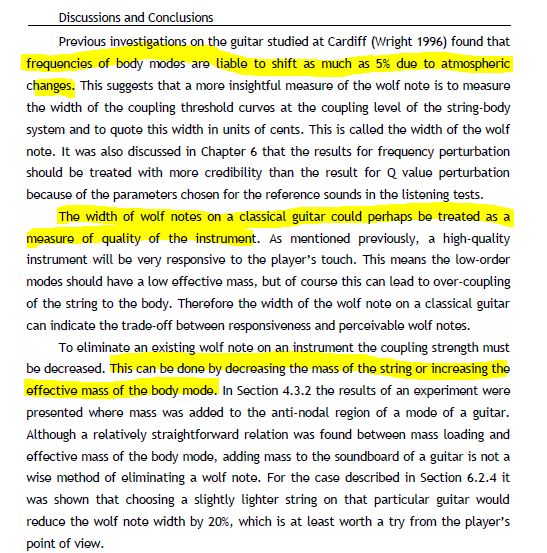
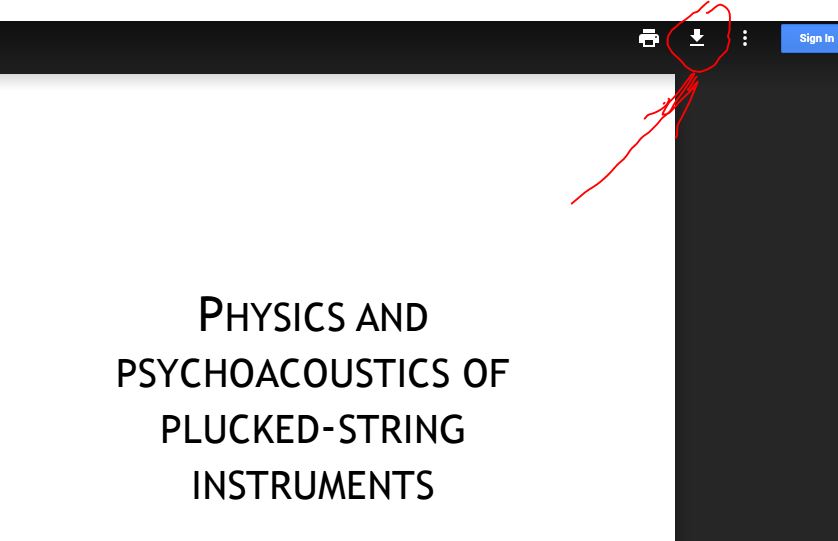
 New Messages
New Messages No New Messages
No New Messages Hot Topic w/ New Messages
Hot Topic w/ New Messages Hot Topic w/o New Messages
Hot Topic w/o New Messages Locked w/ New Messages
Locked w/ New Messages Locked w/o New Messages
Locked w/o New Messages Post New Thread
Post New Thread